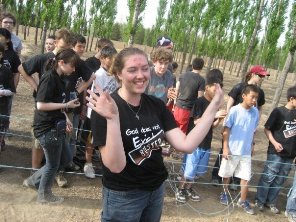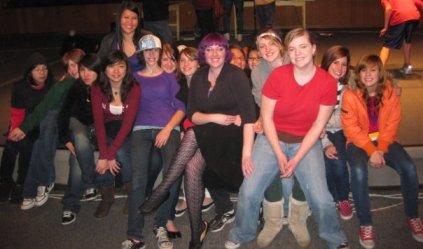The BICF (with support from CCC) runs two camps/conferences every year for expat teens in Beijing. This year’s Spring Conference happened April 2nd-3rd and involved about 200 people. Mark Oestreicher (Marko) came from the US to speak, and the Joe Aylor Worship Band came in from Texas to lead worship.
Four teens from 3 of the 6 youth groups who attended have shared with us some of their reflections on the weekend and what it meant to them. We hope you are encouraged as you read about how these kids were affected. The time and effort put into running events for TCKs really does pay off.
OneWay
Mikaela in an Australian 13 year old who has lived in China for six years. She lives in Zhengzhou, the capital of Henan province – a city of 7 million people located 650km south of Beijing. She joined the OneWay group for the Spring Conference (along with about 20 other teens who live outside Beijing).
Crossroads
Elisa is a 15 year old girl from Finland – who has never lived in Finland. She was born in Switzerland, moved to France at age 2, to the US at 7 and a half, then to China at age 12.
In all the places I’ve lived I’ve never gone to church, never been part of a congregation, never been at Sunday School or had a youth group. Here in China, I joined Crossroads by my own choice, and I love it! Recently, I was a part of the Beijing Expat Youth Conference on the 2nd and 3rd of April and it was amazing!! I consider myself quite a new Christian, and meeting all the other youths was awesome, since we were all there for one purpose: to praise Him and to have fun doing it! The guest speaker, “Marko”, was also super. His funny anecdotes linked his teachings to real life and gave me perspective, which is really important in my opinion. He also used metaphors that I’ve never thought about before when talking about very well-known Bible passages, which really made everything click and made me see just how awesome God’s love is for us! I loved the worship and messages, and it all proved to me once again how amazing our God is, and how our love for Him can move so many to take part in a thing like this! I’m definitely doing it again next year!
Although I’m leaving Maotown in about six weeks, I’m pleased to say that this last Spring Conference I’ve had in my short run here in Beijing has been one of the best experiences I’ve had in my life; Mark-O’s eagle and three-stepper analogies were flawless, and the Joe Aylor crew were amazing in leading us into a time of intimate worship- one that I’ve never experienced to such a passionate degree before. The Holy Spirit flooded the room in its awesome power, and struck like a tidal wave, engulfing every young soul in that place in genuflecting cognizance. It was truly a spectacle to behold. My only regret is not being able to spend an additional two days having the time of my life with fellow brothers and sisters in Christ while also growing closer in wisdom and erudition in seeking after and ‘carrying our crosses’, so to speak, towards Jesus. Conferences should be longer! May the future BICF-CCC conferences thrive further and bring new brothers and sisters into the family of the LORD!
ReGen
Anne is a 16 year old from the USA, but she was born in Hong Kong and has lived in Beijing China her whole life. She is homeschooled and is currently finishing up 10th grade.
At the start of campference this year I was not at all excited or even interested in being there. I kept telling myself that I really didn’t want to go to camp, but I was already signed up. Also, I’m the sort of person who once I start going to an event every fall and spring, I have to go to every one if possible. :) So on Saturday morning I was at the Marriott signing in and getting my camp t-shirt. Once I saw all my friends I began to feel a little better about being at conference. At the start I was also skeptical about the new way of separating by youth group, but I found that I liked it a lot better than I thought I would.
One thing that I always like about camps/conferences is the worship. I like learning new songs and getting excited about it. Over the weekend I was able to learn some of the songs we sang multiple times. Worship was one of my favorite parts of camp.I enjoyed how Marko (the speaker) looked at the passages we read in a new way. It was interesting to think about the people around Jesus, and how they acted. I hadn’t noticed before in the passage about the paralytic being lowered through the roof that his friends had so much faith. Anyways it was good to hear the stories told in a unique way.
One of the parts of camp where I think I learned the most was Tanya’s workshop. Everything was clear, backed up with Bible verses, thought provoking, and helpful for life. I’m not just saying that because Tanya asked me to write for this blog either, I really mean it. Normally when people hand me papers in a Sunday school class or at youth group I can’t think of anything to write in the blank spaces, but in this workshop I barely had time to finish writing everything I had to say. It was really good think about how God refines us to develop purity and strength in us. God taught me, and others as well, a lot from that workshop.
During camp God was teaching me (and still is) to depend on him for everthing, especially joy. On Sunday night before dinner everyone had some free time, and some other people and I were standing around talking. Somehow we started tossing a half-filled waterbottle around, and soon we had a little circle of people throwing around this waterbottle. It was really fun, I’m still not really sure why, but several funny things happened and by the end most of us were laughing so hard we were either on the floor or we were crying. I couldn’t remember the last time I’d laughed so hard. So all that to say, that was the happiest time I had at camp, and it made me even more grateful for the friends God’s given me.
I had a lot of mixed emotions about camp, but overall it was a really positive experience.

